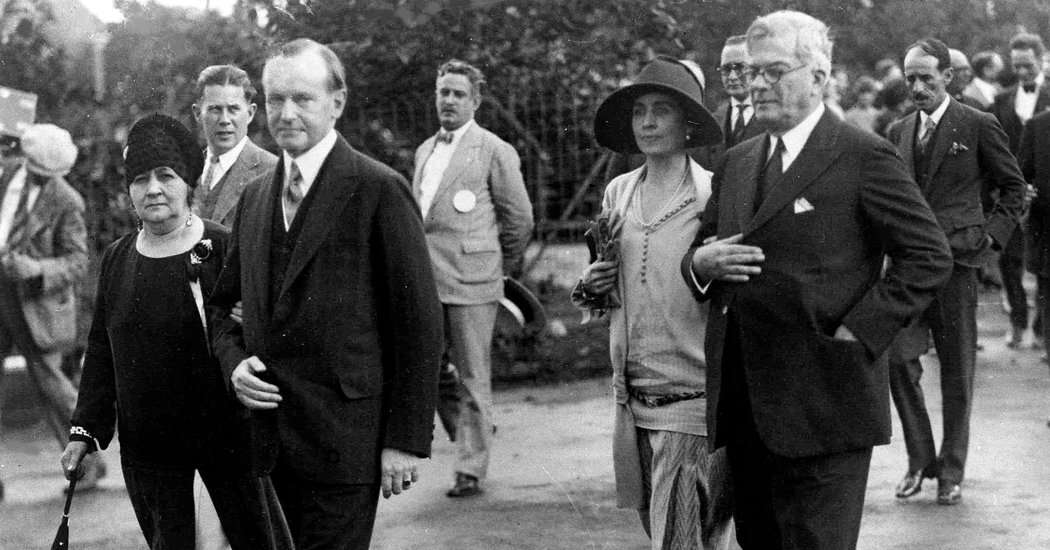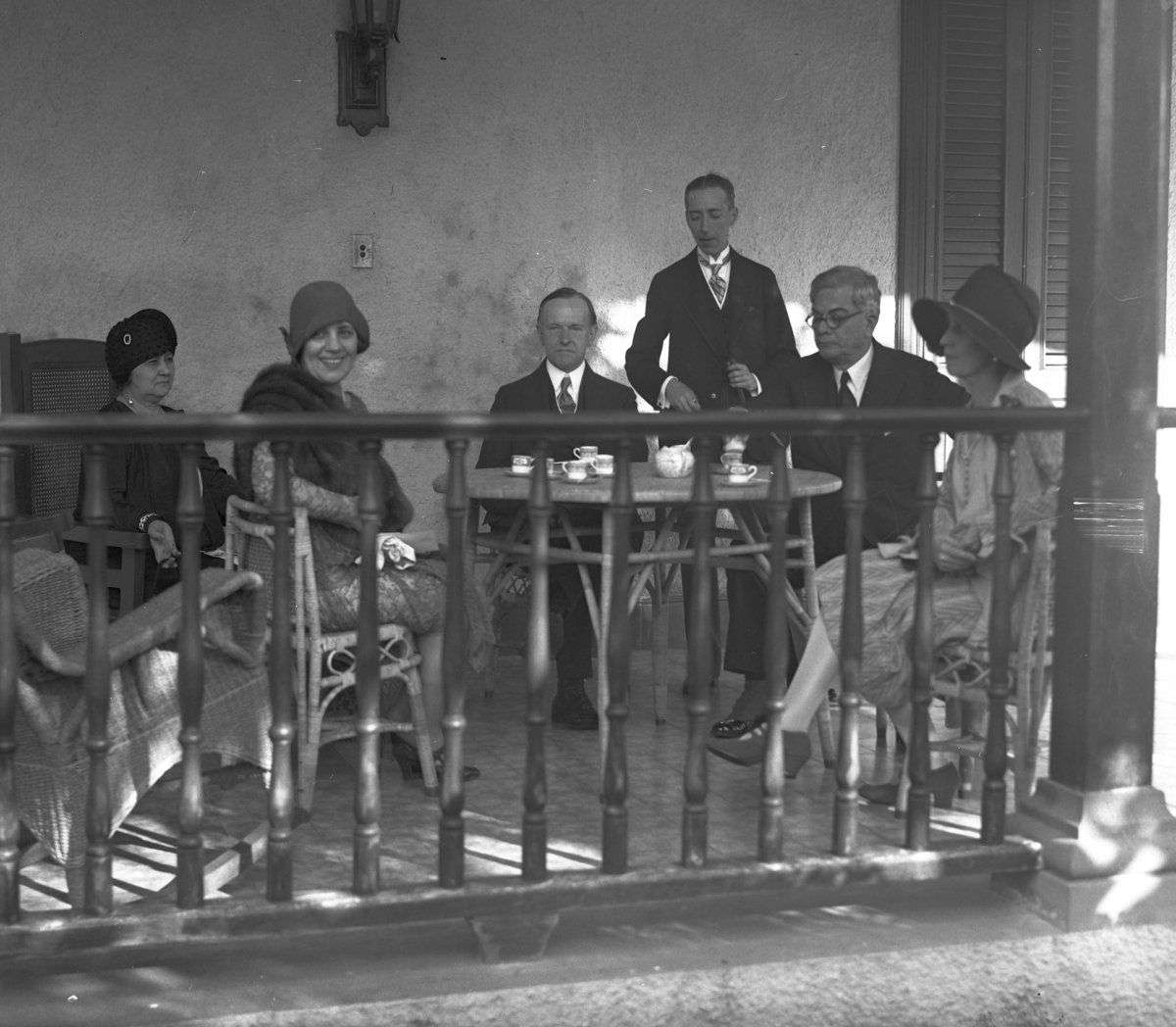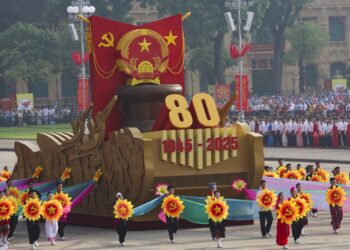In Cuba, President Calvin Coolidge did not give interviews, he only spoke publicly in his speech before the Sixth Conference, delivered at the National Theater, on the sumptuous Paseo del Prado, in front of the Parque Central. Another historic event that not many are aware of also occurred there: the first radio address by a president outside the United States, broadcast throughout the Union by the National Broadcasting Corporation (NBC).
Yet the event, writes one historian, “migrated from the news sections to the social pages,” and in fact became “a celebration of the lifestyles of the rich and famous.” The American women who were in the theater attested, in their own way, to the effects of the modernization process experienced in Havana thanks to the inconstant magic of sugar, which a play by the Alhambra Theater had baptized as “The Dance of the Millions,” when in the world market the pound went from 1.9 cents (1914) to 22.5 (1920). According to The New York Times:
the boxes, the balconies and the orchestra seats were occupied by well-dressed people. The American women said they had never seen — in Europe or anywhere else — an event with such well-dressed women. They praised their Cuban sisters, who were present in large numbers, for having a marked taste in fashion, noting that the dresses, for the most part, were the latest creations from Paris.
The following day, Gerardo Machado organized a banquet for President Coolidge at his estate on the outskirts of Havana; he would also attend a game of jai alai and visit a cane field. In the first case, quite a challenge in the scenario of Prohibition and Puritan values. Historian Joseph R. Conlin explains what the dilemma was for the then President of the United States:
American journalists…held their breath. If Coolidge accepted a drink, it would mean a juicy front-page story. If he rebuffed the waiter with classic New England self-righteousness, his Latin American colleagues would take it as another “Big Brother” insult.
Suddenly, a Cuban gastronome appeared in the room with “a large tray of delicate crystal cups with daiquiris — rum, fresh lemon juice and sugar, all well shaken” — putting “Silent Cal,” so called because of his proverbial parsimony with words, to the test:
As the tray approached him to the left, he slyly turned to the right under the guise of admiring a picture on the wall. The tray moved closer to him. Mr. Coolidge turned another 90 degrees, pointing out to Machado the beauty of tropical greenery. By then he had completed a 360-degree turn, and the incriminating tray had passed behind him. Apparently, he never saw it. His maneuver was a masterpiece of evasive action.
The incident of the waiter and the tray has been repeated ad nauseam from then to date. But the problem is that this rather friendly story consistent with the puritanism of the silent president leaves a very different one in the dark, in part because it is much more comfortable to repeat than to delve. In an article by Glenn Garvin in The Miami Herald, later reproduced in Spanish by El Nuevo Herald, Garvin did what no one else did: track down in depth a text by journalist Beverly Smith, Jr., who had covered Coolidge’s trip for the Saturday Evening Post in 1928 and confessed thirty years later: “A sizeable group of us went to see the local attractions. Not all of them were of a high cultural level.”
Based on his findings, the journalist/researcher relates:
The celebration began when the presidential train, from Washington DC, arrived in Florida and everyone discovered that while the rest of the United States was handcuffed by Prohibition, Key West was, well, Key West.
Its bars weren’t even the underground place known as speakeasies, which required a secret touch or password, to open doors. The train arrived at 10 p.m., and at 6 a.m. reporters and government officials arrived still straggling from Duval Street to their sleeping cars. The drunkards’ singing momentarily turned into sudden shrieks of terror as they crawled under their covers to discover that those who had arrived earlier had put lemon pies on the beds, an act of friendly terrorism. At least one reporter was so completely drunk that he fell into the sea while he was boarding his boat the next morning.
Already in Havana, during the welcome ceremony several hookers appeared from a neighborhood not far from the Palace, as well dressed as those who would attend the National Theater. Coolidge:
began to wave back at them, particularly a group of seven or eight smartly dressed, heavily made-up girls and their flag-waving chaperone. Instantly, everyone but the President had recognized them as the professional representatives of a nearby brothel. When the frightened Coolidge realized who they were, he huddled in his seat, but soon had to call an assistant to sit next to him and shield him from the roses thrown at him by the crowd.

The end of the official activity, almost at sunset,
left reporters free to practice investigative journalism in Havana bars. Among their discoveries was that Machado’s henchmen had warned owners to remove Coolidge’s portraits, out of respect for the sensitive issue of Prohibition, though they were allowed to leave on the wall posters of pilot Charles Lindbergh, who had joined the trip.
Some of the articles that appeared in American newspapers the next morning seem to make it clear that many of the reporters were somewhat drunk even before reporting their stories in the afternoon…. By late afternoon, they were joined by American officials traveling with the President, delighted at the opportunity to drink legally and openly for the first time since Prohibition went into effect…. As alcohol consumption reached gargantuan proportions, high-ranking Havana police officers came with instructions to make sure the gringos felt welcome.
And continues:
To top it all, various members of the group began to spread the word through seedy bars that a reporter from New England who looked a lot like Coolidge was actually the President, which inspired the Cubans’ admiration and numerous offers to buy him drinks. “I suspect that there are still some old Havanans,” Smith wrote in 1959 (sic), “who believe that outside of his office hours Cal was a merry drinker.”
At the end:
Twenty-four hours later, after Coolidge delivered his Havana speech, he visited Machado’s estate south of Havana and watched a game of jai alai, it was time to return to the ships. Saddened at first by the return to Prohibition, the presidential motorcade received the good news that no one, not even reporters, would have to go through U.S. customs in Key West.
Drawn by the smell of that rampant alcoholic temptation, local liquor producers planted themselves in the hotel lobby in Havana. Almost everyone bought half-gallon bottles of rum. Some even bought additional suitcases to fill them with bottles; reporters whose expense accounts were small shed their clothes to make room for the rum. All of this was brought aboard by knowingly winking Marines, leading many to wonder who had approved the gigantic smuggling operation. “Would it have been, incredibly, Calvin himself, in a fit of the whimsical humor some assumed lay behind his sour Vermont face?” reporter Smith wondered.
The trip was a complete success. Former Secretary of State Charles Evans Hughes managed to placate a resolution, promoted by the Argentina of Don Hipólito Irygoyen, condemning the interference in the internal affairs of those Latin American republics. Hughes broke down out of sheer subtlety: “I would not say intervene, but to interpose temporarily to protect the lives and interests of its citizens.” Gerardo Machado was, of course, on the right side: “The Monroe Doctrine is, and must remain, the common defense policy for the territorial integrity of America,” he said.

“Silent Cal” returned to his country pleased with the experience and with everything he learned, including, of course, the National Theater, tropical fruits and the remains of the battleship Maine:
It does not occur to me to say anything new about the Pan American Conference, everything has already been said. Naturally, our government is delighted with my reception in Havana. One of the most pleasurable opportunities that was offered to me there was to travel to the President’s estate, which gave me the opportunity to travel a good number of miles through the Cuban territory, where I was able to observe the people and see something of the progress that they are achieving.
History relates that he arrived in Key West aboard the USS Memphis, seasick from the journey. In the Oval Office he learned that the Havana City Council had voted to rename 17th Street, in El Vedado, after President Calvin Coolidge. “17th Street,” Alejo Carpentier said in 1925, “is one of the most admired by foreigners who come to enjoy the delights of our mild winters, due to its gallery of sumptuous residences.”
Today, like yesterday, Cubans continue to call it by its number.
TN: Quotes in italics were retranslated from the Spanish.










